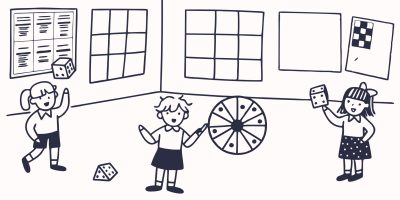Question More, Action Knowledge.
Remember, at QMAK, we don’t just teach; we empower. We don’t just inform; we inspire. We don’t just question; we act. Become a Gold Member, and let’s unlock your child’s full potential, one question at a time.
![]() In a world filled with complexity and uncertainty, the ability to think probabilistically is a superpower. It allows us to make better decisions, assess risks more accurately, and seize opportunities that others might miss.
In a world filled with complexity and uncertainty, the ability to think probabilistically is a superpower. It allows us to make better decisions, assess risks more accurately, and seize opportunities that others might miss.
Nurturing probabilistic thinking is a crucial component of lifelong learning and personal growth.
First, we’ll explore the concept of probabilistic thinking, its key principles, and how it can be applied to various aspects of life. We’ll also discuss strategies for cultivating this valuable skill in both children and adults, empowering them to navigate the complexities of an ever-changing world with greater confidence and wisdom.
At its core, probabilistic thinking involves estimating the likelihood of specific outcomes in situations where complete information is unavailable, and the future is inherently uncertain. It’s about making informed judgments based on the available data, prior knowledge, and an understanding of potential risks and opportunities.
Probabilistic thinking acknowledges that the world is not black and white, but rather a spectrum of possibilities. By embracing this mindset, we can make more nuanced and accurate assessments, avoid the pitfalls of overconfidence, and adapt more readily to changing circumstances.
To effectively apply probabilistic thinking, it’s essential to understand several key concepts:
![]() This approach emphasizes using prior knowledge and experience to evaluate new information. Instead of considering new data in isolation, Bayesian thinking encourages us to update our beliefs based on what we already know. For example, if you’ve historically had positive interactions with a colleague, a single negative incident shouldn’t drastically change your overall assessment of their character.
This approach emphasizes using prior knowledge and experience to evaluate new information. Instead of considering new data in isolation, Bayesian thinking encourages us to update our beliefs based on what we already know. For example, if you’ve historically had positive interactions with a colleague, a single negative incident shouldn’t drastically change your overall assessment of their character.
![]() Unlike the familiar bell curve, where extreme events are rare, fat-tailed curves acknowledge that in some domains, outliers are more common than we might expect. This concept is particularly relevant in fields like finance and geopolitics, where high-impact, low-probability events can have significant consequences. Understanding fat-tailed distributions helps us prepare for and mitigate the risks associated with these extreme outcomes.
Unlike the familiar bell curve, where extreme events are rare, fat-tailed curves acknowledge that in some domains, outliers are more common than we might expect. This concept is particularly relevant in fields like finance and geopolitics, where high-impact, low-probability events can have significant consequences. Understanding fat-tailed distributions helps us prepare for and mitigate the risks associated with these extreme outcomes.
![]() Asymmetries refer to the tendency to overestimate the probability of positive outcomes while underestimating the likelihood of negative ones. For instance, entrepreneurs might focus on the potential rewards of a new venture while downplaying the risks of failure. Recognizing these biases is crucial for making more balanced and realistic probability estimates.
Asymmetries refer to the tendency to overestimate the probability of positive outcomes while underestimating the likelihood of negative ones. For instance, entrepreneurs might focus on the potential rewards of a new venture while downplaying the risks of failure. Recognizing these biases is crucial for making more balanced and realistic probability estimates.
The value of probabilistic thinking extends far beyond academic or professional settings. It can be applied to various aspects of personal life, helping us make better decisions and navigate uncertainty more effectively.
Career Choices: When considering career options, probabilistic thinking encourages us to weigh the potential benefits and risks of different paths. Instead of focusing solely on immediate rewards, we can consider factors like long-term job market trends, the transferability of skills, and the likelihood of future opportunities.

Financial Planning: Probabilistic thinking is invaluable in managing personal finances. By considering the potential risks and rewards of different investment strategies, we can make more informed decisions about allocating our resources. This approach also helps us prepare for unexpected events, such as job loss or medical emergencies, by maintaining an appropriate financial safety net.

Health Decisions: When making choices about our health, probabilistic thinking allows us to weigh the potential benefits and risks of different interventions. For example, when considering a medical treatment, we can evaluate the likelihood of success based on available research, our individual circumstances, and the potential side effects.

Relationships: Probabilistic thinking can help us navigate the complexities of interpersonal relationships. By considering the likelihood of different outcomes based on past experiences and patterns of behavior, we can make more informed decisions about how to communicate, set boundaries, and invest our emotional energy.

Helping children develop probabilistic thinking skills is one of the greatest gifts we can give them. Here are some strategies for nurturing this mindset:
Encourage Curiosity and Questioning

Play Probability Games

Discuss Real-World Examples

Encourage Data-Driven Thinking

Model Probabilistic Thinking

In a world where change is the only constant, probabilistic thinking helps us navigate uncertainty and seize opportunities. By understanding Bayesian thinking, fat-tailed curves, and asymmetries, we can make more informed decisions and manage risks effectively.
By embracing this mindset and cultivating it in the next generation, we create a foundation for navigating life’s complexities with wisdom and adaptability.
Remember, uncertainty isn’t a barrier to success but rather a canvas of possibilities waiting to be explored.
Objective: To identify real-world examples of probability in action.
Objective: To explore the concept of probability through creative writing.
Objective: To understand probability through hands-on experimentation.
Objective: To apply Bayesian thinking to real-life scenarios.
Objective: To apply probabilistic thinking to career decision-making.
The Martian offers a masterful demonstration of probabilistic thinking through astronaut Mark Watney’s fight for survival on Mars.
As Watney faces one life-or-death challenge after another, students witness how calculating probabilities becomes essential for making rational decisions in uncertain conditions.
The film shows probabilistic thinking in action as Watney weighs his options – from calculating food ratios and oxygen supplies to determining the chances of successful communication with Earth.
Through his methodical approach to problem-solving, often expressed through his engaging video logs, viewers learn how breaking down complex situations into probability assessments can help manage risk and improve decision-making.
When Watney famously declares he’ll “science the shit out of this,” he’s really describing a practical application of probabilistic thinking – showing students how this mental model can transform overwhelming challenges into manageable calculations, even when facing seemingly impossible odds.
(Verse 1)
In a world of complexity, where uncertainty reigns
Probabilistic thinking, helps us break the chains
Estimating likelihood, with data and prior knowledge
Navigating risks and opportunities, with wisdom and courage
(Chorus)
The Probability Dance, a rhythm of nuance
Embracing the spectrum, taking a chance
Bayesian thinking, updating beliefs
Fat-tailed curves, preparing for the unknown griefs
(Verse 2)
From career choices to finances, health and relationships too
Probabilistic thinking, guides us through
Weighing benefits and risks, making informed decisions
Adapting to change, with resilience and precision
(Bridge)
Teach the children, this powerful skill
Encourage curiosity, and data-driven will
Play probability games, discuss real-world cases
Model the mindset, in life’s many faces
(Chorus)
The Probability Dance, a rhythm of nuance
Embracing the spectrum, taking a chance
Bayesian thinking, updating beliefs
Fat-tailed curves, preparing for the unknown griefs
(Verse 3)
Embracing uncertainty, seizing opportunities ahead
Probabilistic thinking, a tool to spread
Navigating complexities, with wisdom and grace
A life of learning, growth, and discovery’s embrace
(Outro)
The Probability Dance, let it guide your way
In an uncertain world, let it help you stay
Energized by possibilities, not paralyzed by the unknown
Probabilistic thinking, a skill to hone
Remember, at QMAK, we don’t just teach; we empower. We don’t just inform; we inspire. We don’t just question; we act. Become a Gold Member, and let’s unlock your child’s full potential, one question at a time.